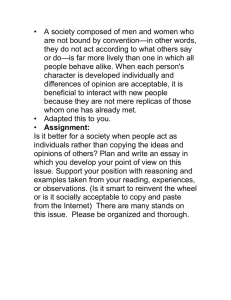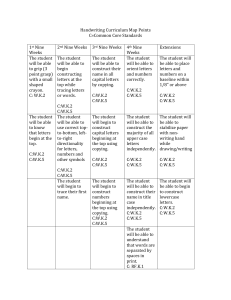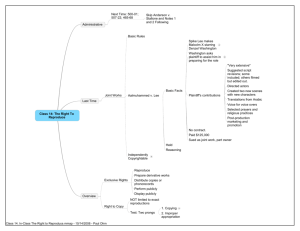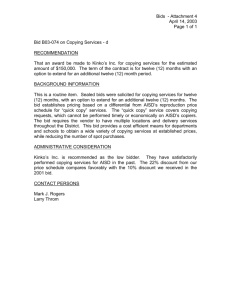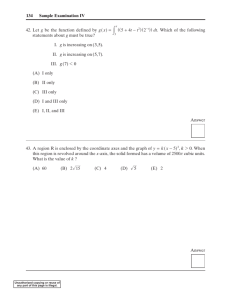Talk - Xin Luna Dong
advertisement
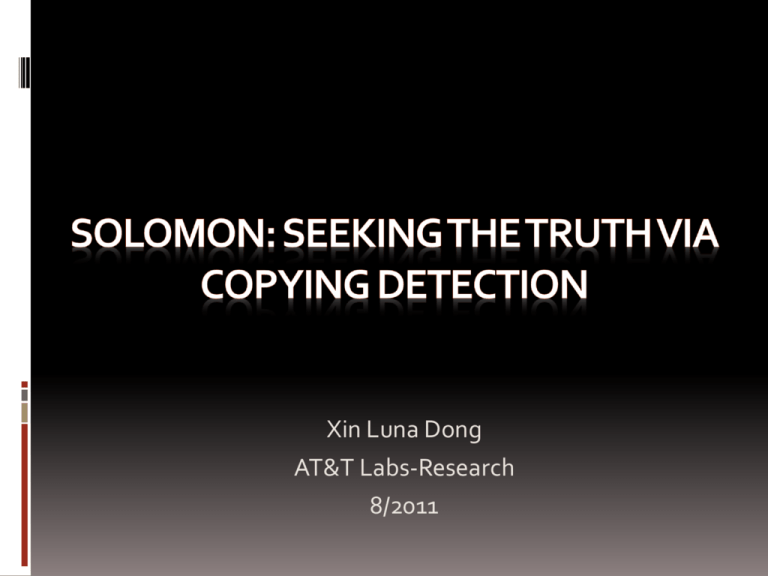
Xin Luna Dong
AT&T Labs-Research
8/2011
We Live in an Information Era
A visualization of the topology of
a portion of the Internet.
Web 2.0
But the Freely Accessible Information Has Its
Downside
Information Propagation Becomes Much
Easier with the Web Technologies
False Information Can Be Propagated (I)
UA’s bankruptcy
Chicago Tribune, 2002
Sun-Sentinel.com
Google News
Bloomberg.com
The UAL stock
plummeted to $3
from $12.5
False Information Can Be Propagated (II)
Maurice Jarre (1924-2009) French Conductor and Composer
“One could say my life itself has been one long soundtrack.
Music was my life, music brought me to life, and music is how
I will be remembered long after I leave this life. When I die
there will be a final waltz playing in my head and that only I
can hear.”
2:29, 30 March 2009
False Information Can Be Propagated (III)
Numerous rumors after the Japan earthquake and
tsunami
“[Please spread the word] From my friend living in Chiba
Prefecture. The weather forecast says it will rain from
Monday. People living around Chiba, please be careful. The
explosion at the Cosmo oil refinery will cause harmful
substance to rise to clouds and become toxic rain. So when
you go“The
out, take
your
raincoat,
make
sure the#Japan.
creator
ofumbrella
Pokemonordied
today and
in the
#tsunami,
rain doesn’t
touch your
RIP: Satoshi
Tajiri.body!”
#prayforjapan.” By xCyrusAndLovato
“The Creator of Hello Kitty, Yuko Yamaguchi, died today in
Relief aid from individuals
Japan. #prayforjapan”
In order to avoid confusion, we ask that you please refrain
[from Chain
distributing
lettersrelief
withsupplies].
specific bank account information for
donations are getting sent around.
Please Help Japan! Earthquake Weapons caused Tsunami
False Information Can Be Propagated (IV)
Posted by Andrew Breitbart
In his blog
…
We now live in this media culture
where something goes up on
YouTube or a blog and everybody
scrambles.
- Barack Obama
The Internet needs a
way to help people
separate rumor from
real science.
– Tim Berners-Lee
Copying Can Happen on Structured Data
(Copying of Weather Data)
Copying Can Be Large Scaled
(Copying of AbeBooks Data)
Data collected
from AbeBooks
[Yin et al., 2007]
Intuitively Meaningful Clusters According to the
Copying Relationships
Intuitively Meaningful Clusters According to the
Copying Relationships
Copying Can Be Large Scaled
(Copying of AbeBooks Data)
Solomon
Goal
Discover copying relationships between
structured data sources
Leverage the copying relationships to improve
various components of data integration
Other applications
Business purpose: data are valuable
In-depth data analysis: information
dissemination
Outline
Solomon
Visualization
and decision
explanation
Applications in
data integration
Copying discovery
• Local detection
[VLDB’09a]
• Global detection
[VLDB’10a]
• Detection w. dynamic
data [VLDB’09b]
• Truth discovery
[VLDB’09a][VLDB’09b]
• Query answering
[VLDB’11][EDBT’11]
• Record linkage
[VLDB’10b]
• Visualization
• Decision
explanation
[VLDB’10 demo]
Problem Definition—Input
Objects: a real-world entity, described by a set of attributes
Each associated w. a true value
Input
Sources: each providing data for a subset of objects
Src
S1
S2
S3
S4
ISBN
Name
Author
1
IPV6: Theory, Protocol, and Practice
Loshin, Peter
2
Web Usability: A User-Centered
Design Approach
1
IPV4:Theory, Protocol, and Practice
2
Web Usability: A User
1
IPV6: Theory, Protocol, and Practice
2
Web Usability: A User
1
IPV6: Theory, Protocol, and Practice
Loshin
2
Web Usability: A User
Lazar
Missing
values
Lazar, Jonathan
Jonathan Lazar
Incorrect
values
Loshin, Peter
Jonathan Lazar
Different
formats
Formatting Patterns for Author List
Problem Definition—Output
For each S1, S2, decide pr of S1 copying directly from S2
A copier copies all or a subset of data
A copier can add values and verify/modify copied values—independent
contribution
A copier can re-format copied values—still considered as copied
Src
S1
S2
S3
S4
ISBN
Name
Author
1
IPV6: Theory, Protocol, and Practice
Loshin, Peter
2
Web Usability: A User-Centered
Design Approach
1
IPV4:Theory, Protocol, and Practice
2
Web Usability: A User
1
IPV6: Theory, Protocol, and Practice
2
Web Usability: A User
1
IPV6: Theory, Protocol, and Practice
Loshin
2
Web Usability: A User
Lazar
S1
S2
Lazar, Jonathan
-
S3
Jonathan Lazar
Loshin, Peter
Jonathan Lazar
S4
Challenges in Copying Detection
Sharing data may be due to both sources providing accurate data
A copier can copy only a small fraction of data
With only a snapshot it is hard to decide which source is a copier
Copying relationship can be complex: co-copying, transitive copying
Src
S1
S2
S3
S4
ISBN
Name
Author
1
IPV6: Theory, Protocol, and Practice
Loshin, Peter
2
Web Usability: A User-Centered
Design Approach
1
IPV4:Theory, Protocol, and Practice
2
Web Usability: A User
1
IPV6: Theory, Protocol, and Practice
2
Web Usability: A User
1
IPV6: Theory, Protocol, and Practice
Loshin
2
Web Usability: A User
Lazar
S1
S2
Lazar, Jonathan
-
S3
Jonathan Lazar
Loshin, Peter
Jonathan Lazar
S4
High-Level Intuitions for Copying Detection
Pr(Ф(S1)|S1S2) >> Pr(Ф(S1)|S1S2)
S1S2
Intuition I: decide dependence (w/o direction)
For shared data, Pr(Ф(S1)|S1S2) is low
e.g., incorrect value
Dependence?
Are Source 1 and Source 2 dependent? Not necessarily
Source 1 on USA Presidents:
Source 2 on USA Presidents:
1st : George Washington
1st : George Washington
2nd : John Adams
2nd : John Adams
3rd : Thomas Jefferson
3rd : Thomas Jefferson
4th : James Madison
4th : James Madison
…
…
41st : George H.W. Bush
41st : George H.W. Bush
42nd : William J. Clinton
42nd : William J. Clinton
43rd : George W. Bush
43rd : George W. Bush
44th: Barack Obama
44th: Barack Obama
Dependence? --Common Errors
Are Source 1 and Source 2 dependent? Very likely
Source 1 on USA Presidents:
Source 2 on USA Presidents:
1st : George Washington
1st : George Washington
2nd : Benjamin Franklin
2nd : Benjamin Franklin
3rd : Tom Jefferson
3rd : Tom Jefferson
4th : Abraham Lincoln
4th : Abraham Lincoln
…
…
41st : George W. Bush
41st : George W. Bush
42nd : Hillary Clinton
42nd : Hillary Clinton
43rd : Mickey Mouse
43rd : Mickey Mouse
44th: Barack Obama
44th: John McCain
High-Level Intuitions for Copying Detection
Pr(Ф(S1)|S1S2) >> Pr(Ф(S1)|S1S2)
S1S2
Intuition I: decide dependence (w/o direction)
For shared data, Pr(Ф(S1)|S1S2) is low
e.g., incorrect data
Intuition II: decide copying direction
Let F be a property function of the data
(e.g., accuracy of data)
|F(Ф(S1) Ф(S2))-F(Ф(S1)-Ф(S2))|
> |F(Ф(S1) Ф(S2))-F(Ф(S2)-Ф(S1))| .
Dependence? -- Different Accuracy
S2 more likely
Are Source 1 and Source 2 dependent? to be a copier
Source 1 on USA Presidents:
Source 2 on USA Presidents:
1st : George Washington
2nd : John Adams
3rd : Thomas Jefferson
1st : George Washington
2nd : Benjamin Franklin
3rd : Tom Jefferson
4th : Abraham Lincoln
4th : Abraham Lincoln
…
…
41st : George W. Bush
42nd : William J. Clinton
43rd : George W. Bush
44th: John McCain
41st : Hillary Clinton
42nd : William J. Clinton
43rd : Mickey Mouse
44th: John McCain
Dependence? -- Different Accuracy
S1 more likely
Are Source 1 and Source 2 dependent? to be a copier
Source 1 on USA Presidents:
Source 2 on USA Presidents:
1st : George Washington
2nd : John Adams
3rd : Thomas Jefferson
1st : George Washington
2nd : Benjamin Franklin
3rd : Tom Jefferson
4th : Abraham Lincoln
4th : Abraham Lincoln
…
…
41st : George W. Bush
41st : George W. Bush
42nd : Hillary Clinton
42nd : Hillary Clinton
43rd : George W. Bush
44th: John McCain
43rd : Mickey Mouse
44th: John McCain
Bayesian Analysis – Basic
S1 S2
Different Values O.Ad
Same Values
TRUE O.At FALSE O.Af
Observation: Ф
Goal: Pr(S1S2| Ф), Pr(S1S2| Ф) (sum up to 1)
According to the Bayes Rule, we need to know
Pr(Ф|S1S2), Pr(Ф|S1S2)
Key: computing Pr(ФO.A|S1S2), Pr(ФO.A|S1S2)
for each O.AS1 S2
Bayesian Analysis – Probability Computation
S1 S2
Different Values O.Ad
Same Values
TRUE O.At FALSE O.Af
Pr
O.At
Independence
1 2
O.Ad
1 c 1 (1 c)
c n (1 c)
P (1 c)
>
2
n
n
n
2
O.Af
Copying
2
2
Pd 1 1
2
2
n
d
ε-error rate; n-#wrong-values; c-copy rate
Considering Source Accuracy
S1 S2
Different Values O.Ad
Same Values
TRUE O.At FALSE O.Af
Pr
O.At
O.Af
O.Ad
Independence
S1 Copies S2
S2 Copies S1
≠
S c P (1 c)
≠ S c P (1 c)
Pt 1 S1 1 S2 1 S1 c Pt (1 c) 1 S 2 c Pt (1 c)
Pf
S1 S 2
n
Pd 1 P t Pf
1
f
Pd (1 c)
2
f
Pd (1 c)
Correctness of Data as Evidence for Copying
Src
S1
S2
S3
S4
ISBN
Name
Author
1
IPV6: Theory, Protocol, and Practice
Loshin, Peter
2
Web Usability: A User-Centered
Design Approach
1
IPV4:Theory, Protocol, and Practice
2
Web Usability: A User
1
IPV6: Theory, Protocol, and Practice
2
Web Usability: A User
1
IPV6: Theory, Protocol, and Practice
Loshin
2
Web Usability: A User
Lazar
S1
S2
Lazar, Jonathan
-
S3
Jonathan Lazar
Loshin, Peter
Jonathan Lazar
S4
Extending the Basic Technique
Consider correctness
of data [VLDB’09a]
Consider additional
evidence [VLDB’10a]
Formatting as Evidence for Copying
Src
S1
S2
S3
S4
ISBN
Name
Author
1
IPV6: Theory, Protocol, and Practice
2
Web Usability: A User-Centered
Design Approach
1
IPV4:Theory, Protocol, and Practice
2
Web Usability: A User
1
IPV6: Theory, Protocol, and Practice
2
Web Usability: A User
1
IPV6: Theory, Protocol, and Practice
Loshin
2
Web Usability: A User
Lazar
Different formats
Loshin, Peter
S1
S2
Lazar, Jonathan
-
S3
Jonathan Lazar
Loshin, Peter
Jonathan Lazar
S4
SubValues
Extending the Basic Technique
Consider correctness
of data [VLDB’09a]
Consider additional
evidence [VLDB’10a]
Consider correlated
copying [VLDB’10a]
Correlated Copying
K
A1
A2
A3
A4
K
A1
A2
A3
A4
O1
S
S
S
D
D
O1
S
S
S
S
S
O2
S
D
S
S
D
O2
S
S
S
S
S
O3
S
S
D
S
D
O3
S
S
S
S
S
O4
S
S
S
D
S
O4
S
D
D
D
D
O5
S
D
S
S
S
O5
S
D
D
D
D
17 same values, and 8 different values
17 same values, and 8 different values
Copying
S: Two sources providing the same value
D: Two sources providing different values
Extending the Basic Technique
Local Detection
Global Detection
[VLDB’10a]
Consider correctness
of data [VLDB’09a]
Consider additional
evidence [VLDB’10a]
Consider correlated
copying [VLDB’10a]
Consider updates
[VLDB’09b]
Multi-Source Copying? Co-copying? Transitive Copying?
S1{V1-V100} (V81-V100 are popular values)
{V1-V50, S2
V101-V130}
S1{V1-V100}
{V1-V50} S2
Multi-source copying
S3 {V21-V70}
Co-copying
S3 {V51-V130}
S1{V1-V100}
{V1-V50} S2
S3 {V21-V50,
V81-V100}
Transitive copying
Multi-Source Copying? Co-copying? Transitive Copying?
S1{V1-V100} (V81-V100 are popular values)
{V1-V50, S2
V101-V130}
S1{V1-V100}
{V1-V50} S2
Multi-source copying
S3 {V21-V70}
Co-copying
S3 {V51-V130}
S1{V1-V100}
{V1-V50} S2
S3 {V21-V50,
V81-V100}
Transitive copying
Local copying detection results
Multi-Source Copying? Co-copying? Transitive Copying?
S1{V1-V100} (V81-V100 are popular values)
{V1-V50, S2
V101-V130}
S1{V1-V100}
{V1-V50} S2
Multi-source copying
S3 {V21-V70}
Co-copying
S3 {V51-V130}
S1{V1-V100}
{V1-V50} S2
S3 {V21-V50,
V81-V100}
Transitive copying
- Looking at the copying probabilities?
Multi-Source Copying? Co-copying? Transitive Copying?
S1{V1-V100} (V81-V100 are popular values)
1
{V1-V50, S2
V101-V130}
S1{V1-V100}
1
{V1-V50} S2
S3 {V21-V70}
Co-copying
1
S3 {V51-V130}
Multi-source copying
1
1
1
S1{V1-V100}
1
{V1-V50} S2
1
1
S3 {V21-V50,
V81-V100}
Transitive copying
X Looking at the copying probabilities?
- Counting shared values?
Multi-Source Copying? Co-copying? Transitive Copying?
S1{V1-V100} (V81-V100 are popular values)
50
{V1-V50, S2
V101-V130}
S1{V1-V100}
50
{V1-V50} S2
S3 {V21-V70}
Co-copying
30
S3 {V51-V130}
Multi-source copying
50
30
50
S1{V1-V100}
50
{V1-V50} S2
50
30
S3 {V21-V50,
V81-V100}
Transitive copying
X Looking at the copying probabilities?
X Counting shared values?
- Comparing the set of shared values?
Multi-Source Copying? Co-copying? Transitive Copying?
S1{V1-V100} (V81-V100 are popular values)
V1-V50
V51-V100
{V1-V50, S2
S3 {V51-V130}
V101-V130}
V101-V130
S1{V1-V100}
V1-V50
Multi-source copying
V21-V70
{V1-V50} S2
V21-V50
S3 {V21-V70}
Co-copying
S1{V1-V100}
V1-V50
{V1-V50} S2
V21-V50, V81-V100
V21-V50
S3 {V21-V50,
V81-V100}
Transitive copying
X Looking at the copying probabilities?
X Counting shared values?
- Comparing the set of shared values?
Multi-Source Copying? Co-copying? Transitive Copying?
S1{V1-V100} (V81-V100 are popular values)
V1-V50
V51-V100
{V1-V50, S2
S3 {V51-V130}
V101-V130}
V101-V130
Multi-source copying
S1{V1-V100}
V1-V50
V21-V70
{V1-V50} S2
V21-V50
S3 {V21-V70}
Co-copying
S1{V1-V100}
V1-V50
{V1-V50} S2
V21-V50, V80-V100
V21-V50
S3 {V21-V50,
V81-V100}
V21-V50 shared by 3 sources Transitive copying
X Looking at the copying probabilities?
X Counting shared values?
X Comparing the set of shared values?
We need to reason for each data item in a principled way!
Global Copying Detection
1. Find a set of copyings R that significantly influence the
rest of the copyings
Maximize
Finding R is NP-complete
We propose a fast greedy algorithm
2. Adjust copying probability for the rest of the copyings:
P(S1S2|R)
Pr(Ф(S1)|S1S2) >> Pr(Ф(S1)|S1S2)
S1S2
Replace Pr(ФO.A(S1)|S1S2) everywhere with
Pr(ФO.A (S1)|S1S2, R), which considers sources that S1
copies from according to R and provide the same value
on O.A as S1
Multi-Source Copying? Co-copying? Transitive Copying?
S1{V1-V100} (V81-V100 are popular values)
V1-V50
V51-V100
?
{V1-V50, S2
S3 {V51-V130}
V101-V130}
V101-V130
Multi-source copying
R={S3S1}, Pr(Ф(S3))= Pr(Ф(S3)|R) for V101-V130
S1{V1-V100}
S1{V1-V100}
V1-V50
V21-V70
{V1-V50} S2
X
?
V21-V50
S3 {V21-V70}
Co-copying
R={S3S1},
Pr(Ф(S3))<<Pr(Ф(S3)|R)
for V21-V50
V1-V50
{V1-V50} S2
?
X
S3
V21-V50, V81-V100
V21-V50
{V21-V50,
V81-V100}
Transitive copying
R={S3S2},
Pr(Ф(S3))<<Pr(Ф(S3)|R) for V21-V50
Pr(Ф(S3)) is high for V81-V100
Experiment Setup
18 weather websites
for 30 major USA cities
collected every 45 minutes for a day
33 collections, so 990 objects
28 distinct attributes in total
SilverStandard
18 weather websites
for 30 major USA cities
collected every 45 minutes for a day
33 collections, so 990 objects
28 distinct attributes in total
Experiment Results
Measure: Precision, Recall, F-measure
C: real copying; D: detected copying
P
CD
D
,R
CD
C
2 PR
,F
PR
Enriched improves over
Corr when true/false
notion does apply
Methods
Precision Recall F-measure
Corr (Only correctness)
.5
.43
.46
Enriched (More evidence)
1
.14
.25
Local (correlated copying)
.33
.86
.48
Global (global detection)
.79
.79
.79
Transitive/co-copying
not removed
Ignoring evidence from
correlated copying
Outline
Solomon
Visualization
and decision
explanation
Applications in
data integration
Copying discovery
• Local detection
[VLDB’09a]
• Global detection
[VLDB’10a]
• Detection w. dynamic
data [VLDB’09b]
• Truth discovery
[VLDB’09a][VLDB’09b]
• Query answering
[VLDB’11][EDBT’11]
• Record linkage
[VLDB’10b]
• Visualization
• Decision
explanation
[VLDB’10 demo]
Data Integration Faces 3 Challenges
Data Conflicts
Instance Heterogeneity
Structure Heterogeneity
Data Integration Faces 3 Challenges
Data Conflicts
Instance Heterogeneity
Structure Heterogeneity
Data Integration Faces 3 Challenges
Scissors
Paper Scissors
Data Conflicts
Instance Heterogeneity
Structure Heterogeneity
Data Integration Faces 3 Challenges
Scissors
Glue
Data Conflicts
Instance Heterogeneity
Structure Heterogeneity
Existing Solutions Assume Independence of
Data Sources
Data Conflicts
Instance Heterogeneity
Assume INDEPENDENCE
of data sources
•Data fusion
•Truth
discovery
Structure Heterogeneity
•String matching (edit distance,
token-based, etc.)
•Object matching (aka. record
linkage, reference reconciliation, …)
•Schema matching
•Model management
•Query answering using views
•Information extraction
Source Copying Adds A New Dimension to
Data Integration
Data
Fusion
Record
Linkage
Query
• Truth discovery
[VLDB’09a, VLDB’09b]
• Online data fusion [VLDB’11]
• Integrating probabilistic data
Data Conflicts
• Improve record linkage
• Distinguish bet wrong values
and alter representations
[VLDB’10b]
Instance Heterogeneity
• Query optimization [EDBT’11]
• Improve schema matching
Structure Heterogeneity
Answering
Source • Recommend trustworthy, upto-date, and independent
Recomsources
mendation
Application I. Truth Discovery—Naïve Voting
S1
S2
S3
Stonebraker
MIT
Berkeley
MIT
Dewitt
MSR
MSR
UWisc
Bernstein
MSR
MSR
MSR
Carey
UCI
AT&T
BEA
Halevy
Google
Google
UW
Application I. Truth Discovery—Naïve Voting
S1
S2
S3
S4
S5
Stonebraker
MIT
Berkeley
MIT
MIT
MS
Dewitt
MSR
MSR
UWisc
UWisc
UWisc
Bernstein
MSR
MSR
MSR
MSR
MSR
Carey
UCI
AT&T
BEA
BEA
BEA
Halevy
Google
Google
UW
UW
UW
Application I. Truth Discovery—Our Solution
S1
S2
S3
S4
S5
Stonebraker
MIT
Berkeley
MIT
MIT
MS
Dewitt
MSR
MSR
UWisc
UWisc
UWisc
Bernstein
MSR
MSR
MSR
MSR
MSR
Carey
UCI
AT&T
BEA
BEA
BEA
Halevy
Google
Google
UW
UW
UW
S1
.87
S2
.2
S4
.2
.99
.99
UCI
AT&T
S1
S2
S3
.99
BEA
S3
S5
Copying Relationship
(1-.99*.8=.2)
S4
S5
(.22)
Truth Discovery
Round 1
Application I. Truth Discovery—Our Solution
S1
S2
S3
S4
S5
Stonebraker
MIT
Berkeley
MIT
MIT
MS
Dewitt
MSR
MSR
UWisc
UWisc
UWisc
Bernstein
MSR
MSR
MSR
MSR
MSR
Carey
UCI
AT&T
BEA
BEA
BEA
Halevy
Google
Google
UW
UW
UW
S1
.14
.08
S2
S4
UCI
AT&T
S1
S2
S3
.49.49 .49
.49
.49
S5
.49
Copying Relationship
BEA
S3
S4
S5
Round 2
Truth Discovery
Application I. Truth Discovery—Our Solution
S1
S2
S3
S4
S5
Stonebraker
MIT
Berkeley
MIT
MIT
MS
Dewitt
MSR
MSR
UWisc
UWisc
UWisc
Bernstein
MSR
MSR
MSR
MSR
MSR
Carey
UCI
AT&T
BEA
BEA
BEA
Halevy
Google
Google
UW
UW
UW
UCI
.12
.06
S2
S4
AT&T
S1
S1
S2
S3
.49.49 .49
.49
.49
S5
BEA
.49
Copying Relationship
S3
S4
S5
Round 3
Truth Discovery
Application I. Truth Discovery—Our Solution
S1
S2
S3
S4
S5
Stonebraker
MIT
Berkeley
MIT
MIT
MS
Dewitt
MSR
MSR
UWisc
UWisc
UWisc
Bernstein
MSR
MSR
MSR
MSR
MSR
Carey
UCI
AT&T
BEA
BEA
BEA
Halevy
Google
Google
UW
UW
UW
.05
S4
AT&T
S1
S2
S1
.10
S2
UCI
S3
.49.48 .50
.48
.50
S5
.49
Copying Relationship
BEA
S3
S4
S5
Round 4
Truth Discovery
Application I. Truth Discovery—Our Solution
S2
S1
S2
S3
S4
S5
Stonebraker
MIT
Berkeley
MIT
MIT
MS
Dewitt
MSR
MSR
UWisc
UWisc
UWisc
Bernstein
MSR
MSR
MSR
MSR
MSR
Carey
UCI
AT&T
BEA
BEA
BEA
Halevy
Google
Google
UW
UW
UW
.09
.04
S4
UCI
AT&T
S1
S2
S1
.49
.47
.51
.49.47
S3
.51
BEA
S3
S5
Copying Relationship
S4
S5
Round 5
Truth Discovery
Application I. Truth Discovery—Our Solution
S1
S2
S3
S4
S5
Stonebraker
MIT
Berkeley
MIT
MIT
MS
Dewitt
MSR
MSR
UWisc
UWisc
UWisc
Bernstein
MSR
MSR
MSR
MSR
MSR
Carey
UCI
AT&T
BEA
BEA
BEA
Halevy
Google
UW
UW
UW
Google
UCI
AT&T
S1
S2
.49
S4
S3
.49.44 .55
.55
.44
S1
S2
BEA
S3
S5
Copying Relationship
S4
S5
Round 13
Truth Discovery
Application I. Truth Discovery (Con’t)
Step 2
Truth
Discovery
Source-accuracy
Computation
Copying
Detection
Step 3
Step 1
Theorem: w/o accuracy, converges
Observation: w. accuracy, converges when #objs >> #srcs
Application II. QA & Online Data Fusion
Where is AT&T
Shannon
Research Labs?
[VLDB’11]
Application II. QA & Online Data Fusion
Where is AT&T
Shannon
Research Labs?
[VLDB’11]
Application II. QA & Online Data Fusion
Where is AT&T
Shannon
Research Labs?
[VLDB’11]
Application II. QA & Online Data Fusion
Where is AT&T
Shannon
Research Labs?
[VLDB’11]
Application II. QA & Online Data Fusion
Where is AT&T
Shannon
Research Labs?
[VLDB’11]
Application II. QA & Online Data Fusion
Where is AT&T
Shannon
Research Labs?
[VLDB’11]
Application II. QA & Online Data Fusion
Where is AT&T
Shannon
Research Labs?
[VLDB’11]
Application II. QA & Online Data Fusion
[VLDB’11]
Where is AT&T
Shannon
Research Labs?
Quickly find answers
Computing probabilities
Source ordering
Outline
Solomon
Visualization
and decision
explanation
Applications in
data integration
Copying discovery
• Local detection
[VLDB’09a]
• Global detection
[VLDB’10a]
• Detection w. dynamic
data [VLDB’09b]
• Truth discovery
[VLDB’09a][VLDB’09b]
• Query answering
[EDBT’11]
• Record linkage
[VLDB’10b]
• Visualization
• Decision
explanation
[VLDB’10 demo]
Copying of AbeBooks Data
AbeBooks data set:
877 bookstores, 1265 CS books, 24364 listings
Copying between 465 pairs of sources
Demo Here
Related Work
Copying detection [Sigmod’11 Tutorial]
Texts
Programs
Images/Videos
Structured sources
Data provenance [Buneman et al., PODS’08]
Focus on effective presentation and retrieval
Assume knowledge of provenance/lineage
Take-Aways
Copying is common on the Web
Copying can be detected using
statistical approaches
Knowing the copying relationship can
benefit various aspects of data integration
Acknowledgements
Laure Berti-Equille
Ken Lyons
(AT&T Research)
(Institute of Research for
Development)
Divesh Srivastava
Xuan Liu
(AT&T Research)
(Singapore National Univ.)
Alon Halevy
Xian Li
(Google)
(SUNY Binhamton)
Yifan Hu
Amelie Marian
(AT&T Research)
(Rutgers Univ.)
Remi Zajac
(AT&T Research)
Songtao Guo
(AT&T Interactive)
Ordered by the amount of time
spent at AT&T
Anish Das Sarma
(Google)
Beng Chin Ooi
(Singapore National Univ.)
http://www2.research.att.com/~yifanhu/SourceCopying/
What Is Missing? (a.k.a. Future Work)
Local Detection
Loop copying
Copying by category
Summarizing copying
patterns
Exploring evidence from
schemas, tuple ordering,
etc.
Scalability
Detecting opinion
influence
Global Detection
Hidden Sources
Global detection for
dynamic data
What is Missing (a.k.a. Future Work)
Data
Fusion
Record
Linkage
• Truth discovery
[VLDB’09a, VLDB’09b]
• Integrating probabilistic data
• Improve record linkage
• Distinguish bet wrong values
and alter representations
[VLDB’10b]
• Query optimization
[Submitted]
Answering • Improve schema matching
Query
Source • Recommend trustworthy, upto-date, and independent
Recomsources
mendation
Data Conflicts
Instance Heterogeneity
Structure Heterogeneity
Future Work: Explaining Copying-Detection
Decisions
Provide the simplest, understandable
explanation for Bayesian analysis
A copying detection decision is complex
Why copying?
Why a particular copying pattern (per-object copying vs. per-attribute
copying)?
Why a particular copying direction?
Why the local decision is different from the global decision?
Answer “what-if” questions
What if the two sources actually use the same format for those
common values?
What if there is a hidden source that S1 and S2 both copy from?
Answer “comparison” questions
Why S1 is a copier of S2 but not a copier of S3?
Why S1 has copied attributes “title” but not “authors”?
Experiment on Static Data [VLDB’09a]
Dataset: AbeBooks
877 bookstores
1265 CS books
24364 listings, w. ISBN, name, author-list
After pre-cleaning, each book on avg has 19
listings and 4 author lists (ranges from 1-23)
Golden standard: 100 random books
Manually check author list from book cover
Measure: Precision=#(Corr author lists)/#(All lists)
Naïve Voting and Types of Errors
Naïve voting has precision .71
Error type
Missing authors
Additional authors
Mis-ordering
Mis-spelling
Incomplete names
Num
23
4
3
2
2
Contributions of Various Components
Considering copying
improves the results most
Methods
Naïve
Only value similarity
Only source accuracy
Only source copying
Copy+accu
Copy+accu+sim
Precision improves by
25.4% over Naïve
Prec
.71
.74
.79
.83
.87
.89
#Rnds Time(s)
1
.2
1
.2
23
1.1
3
28.3
22
185.8
18
197.5
Reasonably fast
Experiment on Dynamic Data [VLDB’09b]
Dataset: Manhattan restaurants
Data crawled from 12 restaurant websites
8 versions: weekly from 1/22/2009 to 3/12/2009
5269 restaurants, 5231 appearing in the first crawling and
5251 in the last crawling
467 restaurants deleted from some websites, 280 closed
before 3/15/2009 (Golden standard)
Measure: Precision, Recall, F-measure
G: really closed restaurants; D: detected closed restaurants
P
GD
D
,R
GD
G
2 PR
,F
PR
Discovered Copying
Between 12 out of 66 pairs copying is likely
Contributions of Various Components
Naïve missed a lot of restaurants
Method
Ever-existing
Applying rules is inadequate
Closed
#Rnds
Time(s)
#Rest
Prec
Rec
F-msr
ALL
-
.60
1.0
.75
-
-
ALL2
-
.94
.34
.50
-
-
Naïve
1192
.70
.93
.80
1
158
Quality
5068
.83
.88
.85
7
637
CopyQua
5186
.86
.87
.86
6
1408
Google
-
.84
.19
.30
-
-
Quality and CopyQua obtain
high precision and recall
Google Map listed a lot of outof-business restaurants

